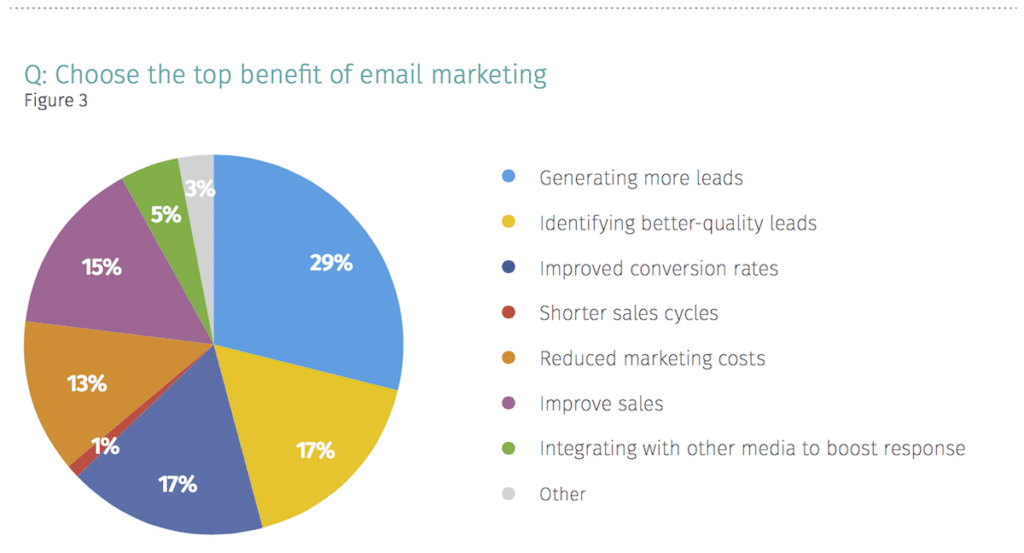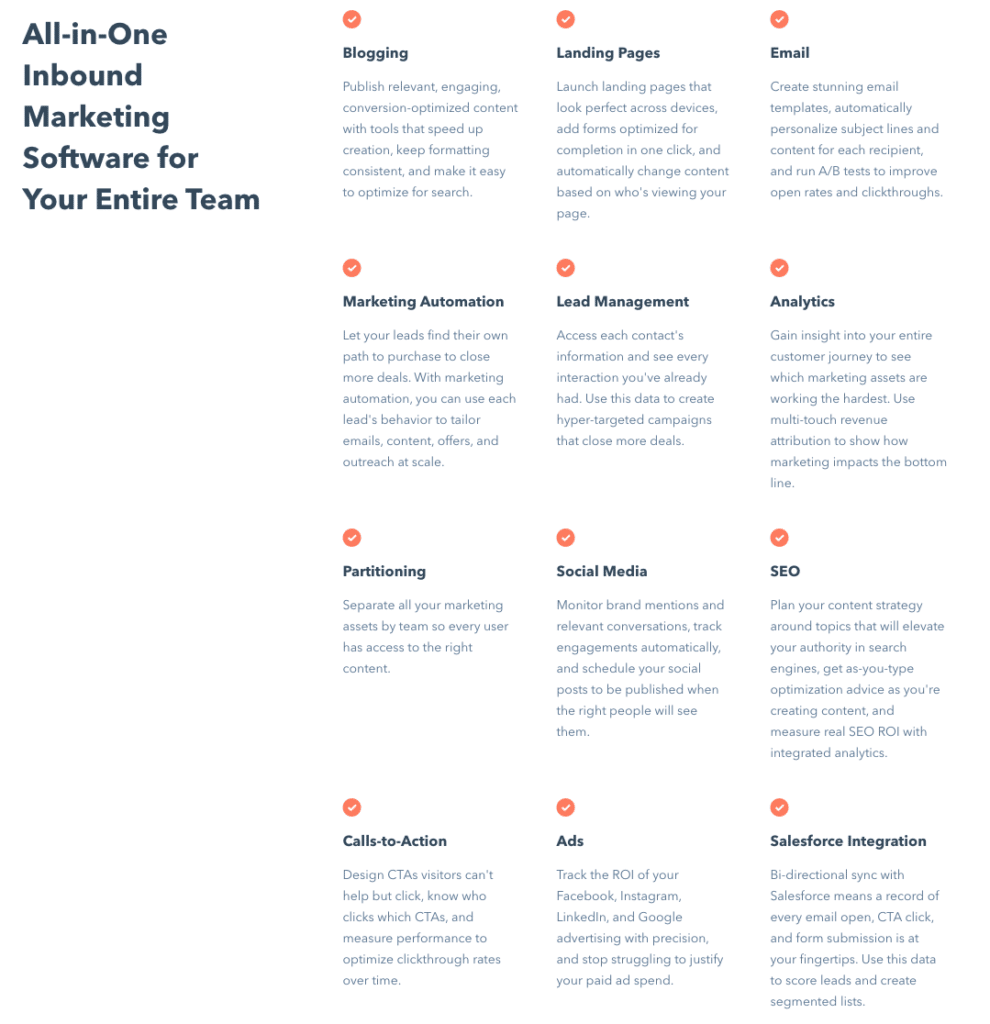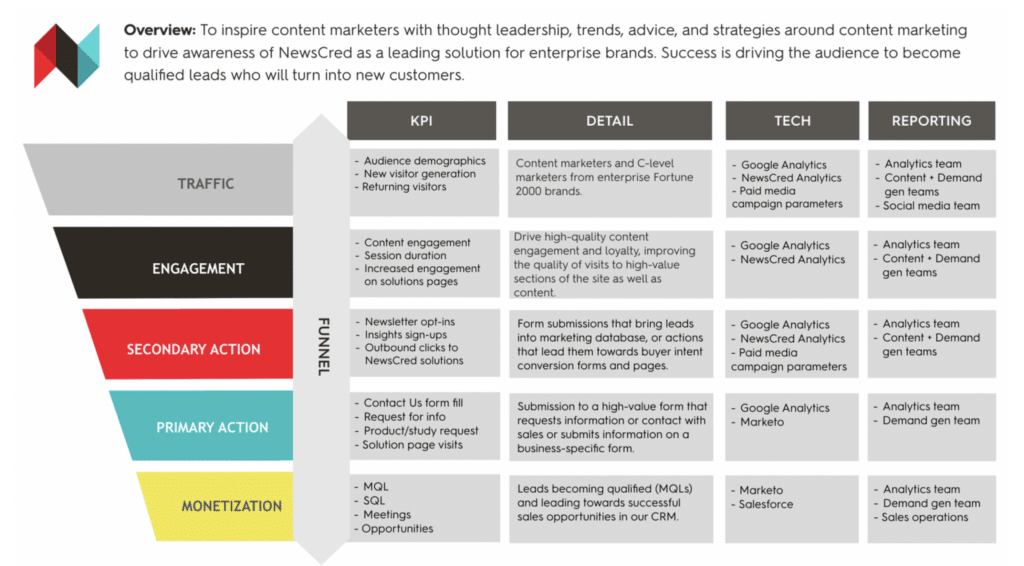When companies reach out to me for marketing help, they are usually dealing with major challenges around lead generation and sales enablement that have revenue opportunities attached. These challenges are common and in a nutshell, they exist due to the lack of processes, tools, and people. More importantly, failing to build a culture around collaboration for overall business success becomes a competitive game that turns marketing and sales teams against each other.
In turn, this creates friction and less streamlined processes for progressive work to be done. Even though there isn’t an easy solution to this in terms of “culture”, a great place to start is to have the following nailed down:
- Business objectives
- Marketing goals
- Sales goals
- Agreement for tools that will be used to track and measure success
- Processes that will be implemented to move the needle as a team
- People who are team players and understand their roles and responsibilities
Let’s face it, marketing’s job of revenue contribution has risen over the past 4-5 years, which means that the responsibility of generating quality leads goes beyond TOFU and MOFU engagements. After all, understanding the types of leads, channels, and programs that yield the highest ROI is top of mind for businesses that want to grow their sales.

Sales and Marketing Stats to Know
In order to deeply understand why lead gen, sales enablement, and filling up the pipeline is such a challenge for B2B companies, we need to look at the following stats:
- More than 40% of salespeople say prospecting is the most challenging part of the sales process, followed by closing (36%) and qualifying (22%).
- More than 50% of prospects want to see how your product works on the first call.
- 80% of sales require 5 follow-up calls after the meeting.
- 44% of sales reps give up after 1 follow-up.
- B2B buyers are 57%-70% through buying research before contacting sales.
- The average Lead to Close length is 102 days.
- 80% of business decision-makers prefer to get company information from a series of articles versus an advertisement.
- 84% of CEOs and VPs use social media to make purchasing decisions.
- 93% of B2B buying processes begin with an online search.
- 94% of B2B buyers will research online before finalizing a purchase.
- 75% of surveyed executives are willing to make an appointment or attend an event based on a cold call or email alone.
- Only 39% of a sales rep’s time is spent selling or interacting with prospects and customers.
- 85% of salespeople are active on LinkedIn.
- 55% of companies think that sales representatives need to improve their ability to incubate promising leads for the future.
Hack #1 — Run Social Media Ads
One of the fastest ways to get feedback on the type of messaging that works well in creatives that influence potential customers is to run ads. More specifically, I recommend social media ads.

In the B2B world, LinkedIn is a key place to run ads to attract website visitors, as well as leads. Secondary to that, I’d recommend checking out Facebook ads. You’d think that Facebook ads are just good for consumer-based businesses, but that’s actually the opposite of what I’ve experienced when running ads within the B2B space.
That being said, consider the following with your social media advertising strategy:
- Push for lookalike audience targeting (FB)
- Implement retargeting and then develop a lookalike audience based on that (FB)
- Target based on persona and job titles, narrowing down to industries and seniority level
- Try out lead forms on LinkedIn
- Diversify the messaging and CTAs
- Diversify the landing page copy
- Execute multivariate and A/B testing where it makes the most sense
- Use content assets to your advantage (e.g. guides, infographics, webinars, datasheets, etc.)
When running social media ads, I suggest sending leads to a landing page rather than just sending them to your home page. This way, you can provide your audience with exactly what information they want based on the ad they clicked.
I recommend Instapage to help you create landing pages because it is easy to use and features 6 products in 1 platform, enabling you to analyze the effectiveness of your landing page and improve it as needed. Instapage also helps you customize the landing page for each ad and target audience, helping give your potential clients exactly the information they are looking for.
Hack #2 – Create Streamlined Workflows
In most cases for B2B marketing, you’ll find that your ads (if they are set up and optimized correctly), will generate legitimate leads. Your next step — once you have some contact info from prospective customers — is to make sure that you leverage email marketing.

What works the best for email marketing when it comes to nurturing qualified leads is to automate where you can. This will make you much more productive and effective with your time.
That being said, here are some best practices to follow:
- Segment leads by persona.
- Segment leads by lifecycle stages.
- Lead scoring should be implemented.
- Continue testing messaging, CTAs, and design elements.
- Make sure everything syncs from your marketing automation tool to your CRM so that both sales and marketing are clear on what’s working and who’s moving further down the buyer journey.
Hack #3 – Choose Your Marketing Automation Tool
It shouldn’t come as a surprise that there’s no shortage of marketing automation tools to pick from. That makes your job a little harder because if you’re green when it comes to digital marketing, it can be difficult to know what features you should be looking for.
The most important thing to consider is what type(s) of marketing you want to focus more on. Content, social media, and email marketing require very different sets of tools. Ideally, you’ll find a platform that enables you to tackle all of them together so you don’t have to pay for multiple services.
With that in mind, here’s what you need to be on the lookout for:
- A high degree of customizability. You want to be able to configure every single marketing automation your business is going to rely on. Some platforms rely too heavily on pre-built automatizations, which makes them a poor option.
- Multiple sets of plans. Marketing automation tools tend to be very expensive. This means that there aren’t a lot of good options for small businesses, which are the ones that should be leveraging these types of tools to drive aggressive growth.
- Easy to use. Let’s be honest: automating online marketing isn’t and shouldn’t be a cakewalk. In some cases, we’re talking about complex marketing campaigns that span dozens of steps, so there’s going to be a learning curve. Even so, the marketing automation tools you use shouldn’t require a Ph.D.
To save you time, let’s take a look at two highly rated tools, HubSpot and Ontraport. First, you’ll be given a quick introduction to both tools and then a comparison of their features and ease of use.
Let’s start with HubSpot
HubSpot is one of the biggest names in marketing, and they offer multiple types of services, including:
- Customer relationship management (CRM) software
- Marketing automation functionality (with a focus on content)
- Sales and lead-management tools
- A customer service hub
When you combine all of that functionality, you get an all-in-one platform that can handle everything from contacts to sales, lead management, customer service, and marketing automation.

As far as marketing automation goes, HubSpot provides you with content creation functionality, as well as email and social media management tools. You also get access to in-depth analytics for every tool you use, which makes it easy to see how well your campaigns are performing.
Let’s talk about Ontraport
Ontraport is a top pick because, like HubSpot, they offer a lot more functionality than you’d expect from a marketing automation tool.
If you use Ontraport, you get access to a CRM system, email and landing page builders, SMS-marketing tools, and more. They even enable you to implement postcards within your marketing strategy.
Overall, Ontraport focuses on email marketing a lot more than HubSpot, which emphasizes content creation.

Beyond that, they also include shopping-cart tools, affiliate management functionality, webinar creation systems, and more.
That’s a very quick summary, though, so let’s dig down and compare the two platforms in several aspects, including features, ease of use, and pricing. That way, you’ll have all the data you need to make an informed decision.
HubSpot vs. Ontraport: Feature Comparison
When it comes to the sheer range of features, HubSpot has a clear lead over Ontraport. That’s because Hubspot provides a broader range of services. However, if you focus only on marketing, here’s what you get when you use HubSpot:
- Access to blogging tools that enable you to manage your content using an editorial calendar
- Tools to help you build and test landing pages
- Create, personalize, test, and send email marketing campaigns
- Manage your social media marketing, including monitoring your competitors, scheduling publications, and tracking engagement
- Design CTAs and measure their performance
- Track the performance of your ads across multiple platforms, including Facebook, Instagram, LinkedIn, and Google
- Integrate your marketing hub with third-party applications, which you can check out for yourself
Here’s what you get as an Ontraport user when it comes to marketing features:
- All the basics when it comes to email campaigns, including a visual builder, personalization functionality, split testing, and more
- Choose from a broad library of templates to kickstart your email campaigns
- Design and publish landing pages using a drag-and-drop builder and templates
- Score your leads and use that data to drive your outbound marketing efforts
- Manage your Facebook ads
- Create and share personalized URLs with your customers
Finally, the point of automation is to save you time so you can focus on other aspects of your business. With marketing automation, you’re entrusting a platform with the systems that bring in new clients and money to your business.
That sounds a bit scary, but both HubSpot and Ontraport enable you to customize every aspect of the automation process. You choose what processes to automate and exactly how to do it. That usually requires a lot of upfront work, but the results should pay for themselves in the long run.
Hack #4 – Nail Down Your Messaging
Messaging is going to be key in every single thing you do because it’s going to be a huge predictor of what influences your target customers to actually buy from you.
That being said, make sure content, in general, is a top priority and continues to be. This includes everything from blogging to creating longer-form content that is downloadable. Here are some quick tips I provided in a previous blog post:
Create Lead Magnets
B2B lead generation requires you to master the art of the lead magnet — a high-value item or tool with a low entry point for buyers (most lead magnets are free, while some may charge a small fee). Lead magnets are usually some form of content that the user will find helpful enough where they’re willing to give up their name and email address.

A lead magnet itself is a powerful tool to boost lead collection, but know that it is also about creating an entire ecosystem that’s multi-channeled. Doing so will nurture leads who come in the door and help you segment which ones are marketing qualified and sales qualified.
Create Impactful Content Focused on Customer Lifecycle Stages
There’s no arguing that content marketing should be part of your mix, but take your efforts a step further by creating content that speaks to each stage of the buying cycle.
Start with understanding your buyers’ needs, questions, and problems, then develop content that addresses these aspects. From there, consider where the buyer is in their decision-making stage: if they’ve just discovered a problem, they may not be as ready to pull the trigger as someone who is actively exploring solutions. Here are some suggestions to inspire you:
- Awareness Stage: Content should focus on answering questions, solving problems, and informing without sounding salesy.
- Consideration Stage: Content should start presenting solutions to problems and discussing options. A free demo or webinar could work well here.
- Decision Stage: Content should include a call to action or incentive to buy, such as a discount or free trial.
Delivering content to customers depending on where they are in the buying journey caters to their needs in a deeper, more meaningful way. You’re speaking directly to their present situation and can move them through your funnel faster.

Hack #5 – Team Work Makes the Dream Work
An all-too-common scenario in many B2B companies is that sales are constantly complaining that they don’t have enough leads, while marketing feels that the leads they are sending over aren’t being followed up. There is validity to this last point because sales reps are known to ignore 50% of marketing leads. However, when both sales and marketing are in alignment, it can lead to 38% higher sales win rates.
That said, here are key stats to know:
- Organizations with tightly aligned sales and marketing functions enjoy 36% higher customer retention rates.
- Sales and marketing alignment can help your company become 67% better at closing deals.
- Aligning both departments can help generate 209% more revenue from marketing.
- Companies with strong sales and marketing alignment achieve a 20% annual growth rate.
- Companies with poor sales and marketing alignment can cost 10% or more in revenue decline.
The most important factor with successful collaboration is that everyone is accountable and that both parties do their part. The friction between sales and marketing arises and can continue when there isn’t accountability because then it’s all about finger-pointing. In turn, this causes teams to pull apart rather than working towards the same vision and goals.
Wrapping It Up
I call these “hacks” because they’re meant to be as fluid as possible — meaning you’re stubborn about the overall business objectives, but your approach is flexible. To me, hacks allow you to grow and learn quickly. They aren’t meant to be the only way, but they will help guide you in collecting as many data points as possible to help make better decisions.
In whatever you do with your marketing, make sure that you are steadfast with the changing landscape that digital marketing brings and that you are open to testing. Doing so will help you navigate the competitive landscape you’re facing and also focus on what drives the most revenue.
Disclosure: Please note that some of the links above are affiliate links. I only recommend products and services that I use and stand behind, and if you decide to try them, I will earn a commission at no cost to you. Doing so helps me run this blog and provide free content for you, my readers.